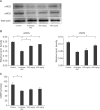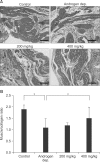Protective Effects of KH-204 in the Bladder of Androgen-Deprived Rats
- PMID: 26331123
- PMCID: PMC4550599
- DOI: 10.5534/wjmh.2015.33.2.73
Protective Effects of KH-204 in the Bladder of Androgen-Deprived Rats
Abstract
Purpose: We investigated the protective effects of the herbal formulation KH-204 in the bladder of androgen-deprived rats.
Materials and methods: Male rats aged eight weeks were randomly divided into four groups, containing eight rats each: sham operation only (normal control group), androgen-deprived only (androgen-deprived control group), and androgen-deprived followed by treatment with 200 mg/kg or 400 mg/kg of KH-204. After 0.5 mg/kg of leuprorelin was subcutaneously injected in the androgen-deprived groups, the oral administration of either distilled water in the two control groups or KH-204 in the treatment group was continued for four weeks. Serum testosterone levels, RhoGEF levels, nitric oxide (NO)-cyclic guanosine monophosphate (cGMP)-related parameters, oxidative stress, and histologic changes were evaluated after treatment.
Results: Treatment with the herbal formulation KH-204 (1) increased serum testosterone levels; (2) restored the expression of RhoGEFs, endothelial NO synthase, and neuronal NO synthase; (3) increased the expression of superoxide dismutase; and (4) decreased bladder fibrosis.
Conclusions: Our results suggest that the positive effects of KH-204 on the urinary bladder may be attributed to its antioxidant effects or to an elevation in NO-cGMP activity.
Keywords: Antioxidants; Hypogonadism; Phytotherapy; Testosterone; Urinary bladder.
Conflict of interest statement
Figures





References
-
- Wang C, Nieschlag E, Swerdloff R, Behre HM, Hellstrom WJ, Gooren LJ, et al. International Society of Andrology; International Society for the Study of Aging Male; European Association of Urology; European Academy of Andrology; American Society of Andrology. Investigation, treatment, and monitoring of late-onset hypogonadism in males: ISA, ISSAM, EAU, EAA, and ASA recommendations. Eur Urol. 2009;55:121–130. - PubMed
-
- Wu FC, Tajar A, Beynon JM, Pye SR, Silman AJ, Finn JD, et al. EMAS Group. Identification of late-onset hypogonadism in middle-aged and elderly men. N Engl J Med. 2010;363:123–135. - PubMed
-
- Wu CY, Yu TJ, Chen MJ. Age related testosterone level changes and male andropause syndrome. Chang Gung Med J. 2000;23:348–353. - PubMed
-
- Feldman HA, Longcope C, Derby CA, Johannes CB, Araujo AB, Coviello AD, et al. Age trends in the level of serum testosterone and other hormones in middle-aged men: longitudinal results from the Massachusetts male aging study. J Clin Endocrinol Metab. 2002;87:589–598. - PubMed
-
- Wu FC, Tajar A, Pye SR, Silman AJ, Finn JD, O'Neill TW, et al. European Male Aging Study Group. Hypothalamic-pituitary-testicular axis disruptions in older men are differentially linked to age and modifiable risk factors: the European Male Aging Study. J Clin Endocrinol Metab. 2008;93:2737–2745. - PubMed
LinkOut - more resources
Full Text Sources
Other Literature Sources

